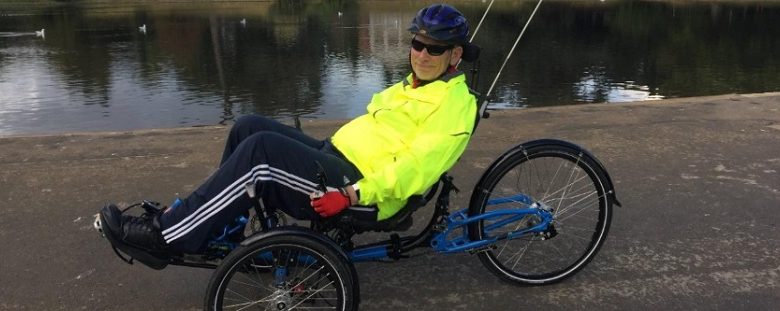
How cycling helped Nick rediscover who he was after a stroke
A stroke changes someone’s life. That is certainly true for Nick Cole, a former senior ICT Project Manager. A stroke had given him, in his words, a ‘scrambled egg’ brain. But the stroke did not change everything. Nick is as passionate about cycling after his stroke as before it. This is Nick’s story. It is a narrative about continuity and change, about how cycling improved Nick’s health and gradually made him feel like his pre-stroke, endorphin-junkie-self again.
Becoming an endorphin junkie through cycling
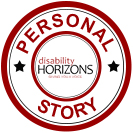 On my 50th birthday in 2003, I decided to do something about my weight and general lack of fitness. I bought an at-home exercise bike and after a year of sweating away in private, I decided I was fit enough to be seen in public. So I took my bulk, joined a local gym and started cycling to work. By late spring in 2009, I was going or 50km bike rides. I was well on my way to becoming an endorphin junkie.
On my 50th birthday in 2003, I decided to do something about my weight and general lack of fitness. I bought an at-home exercise bike and after a year of sweating away in private, I decided I was fit enough to be seen in public. So I took my bulk, joined a local gym and started cycling to work. By late spring in 2009, I was going or 50km bike rides. I was well on my way to becoming an endorphin junkie.
20th June 2009 – struck by a stroke
On the morning of Saturday 20th June 2009, I was woken by my wife, Letizia, who told me that the window cleaner wanted me to shift my car. I had been working late the previous evening in my job as an ICT Project Manager after a stressful week and may have slightly over-indulged on the wine. But I did not have a hangover (honest!).
What I did have, I realised to my horror, was only limited and intermittent feeling in the whole right side of my body. I later discovered that I was having a stroke. My wife called 999 and the ambulance arrived in what seemed like only minutes.
That is where my memory gets patchy and fades. I remember being taken out on a stretcher and going around the posts at the bottom of the stairs, but that is all.
Reminiscence from a hospital bed…
My thoughts drifted to me sitting in the sun with my bike on my favourite bench up by the Royal Ballet School in Richmond Park, West London. In my mind, it was late spring in 2009 and I was thinking about how fortunate I was to be a 56-year-old, somewhat overweight but otherwise fit chap living within cycling distance of three wonderful London parks – Gunnersbury, Richmond, and Bushy.
My daydream was brought to an abrupt end by a nurse standing over me wanting to know my menu choices for the day. It was autumn and I was in the Regional Rehabilitation Unit (RRU) of Northwick Park hospital.
I was recovering from the massive haemorrhagic stroke I had. Menu choices were one of my more difficult daily mental exercises due to my ‘scrambled egg’ brain, as I called it back then.
In my past, pre-stroke life, I had juggled complex ICT projects in places including Russia, Ukraine and Kazakhstan. Now my toughest daily dilemma was between fresh fruit (my wife Letizia’s recommendation) and duff pudding and custard (my guilty hospital food pleasure).
A stroke is as if a jigsaw has dropped and you need to find the scattered pieces
It is difficult to explain how you feel immediately after a stroke. No two strokes are the same. In my case, it is summed up in two words: total bewilderment. My memories of past events leading up to the stroke were fine. I knew what I used to be. But what am I now and in the future?
One analogy is the ‘dropped jigsaw puzzle’. Imagine you are doing a jigsaw puzzle on a tray and someone asks you to move and, in doing so, you drop it on the floor. Some sections of the puzzle may be intact, and some may hold together with a few of their neighbours. But some will be thrown to the four winds. That’s what happened to my grey matter.
Recovering from my stroke
The two months after the stroke was a blur. I only had vague, dream-like and, generally, unpleasant memories. My first solid memory was of being taken in an ambulance to the RRU where Letizia and a team of nurses were waiting to greet me. Piecing together my memory of events after nine years, I realise now that the combination of a demanding, stressful job and high blood pressure had caused a ‘gasket to blow’ in my head.
Subsequently, most of my time was taken up by physiotherapy, occupational therapy (OT) and stroke-survivor discussion groups that quickly turned into moaning sessions. When I finally left the RRU on 1st April 2010, I could walk 10 meters with a stick. A wheelchair has, up until today, been my default means of transport. According to Letizia, I have recovered 80% of my intellect.
Taking up cycling again and finding the right bike
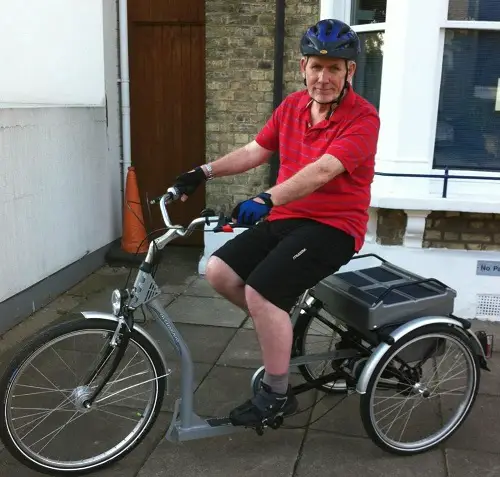
In 2010, I was desperate to get back to my passion for cycling, but a two-wheel bike was out of the question. Although my balance was intact, I was now ‘lopsided’. I still had some strength in my right leg, but limited feeling, and the direction I could apply the force to, was unpredictable. This caused me to hold back for fear of injuring myself. I certainly could not pedal fast enough to achieve dynamic stability, stop wobbling and make any decent headway.
I investigated tricycles. Initially, I bought a conventional delta – one wheel at the front and two at the back, like a big kiddie’s trike with a low-step mount designed for the less agile. But I still needed help to mount it and I felt a bit precarious on it.
The other issue was my right foot, which needed to be secured on the pedal to avoid it dropping down on the road and me running over myself (ouch!). But despite its shortcomings, this trike allowed me to fulfil my first goal – sitting in the sun on my bench in Richmond Park.
I decided I needed a more stable trike. After much investigation, I found the best solution for me was a recumbent ‘tadpole’ trike, with one wheel at the back and two at the front. Unlike the delta trike, this bike is inherently stable as it has a low centre of gravity and can be ridden at hair-raising speeds without fear of tipping over.
I also acquired a turbo trainer. This is a device that allows me to pedal under variable loads to simulate road conditions, and allowed me to train at home all year round. An app on my smartphone played videos of Richmond Park and elsewhere, which gave me a way of measuring my progress.
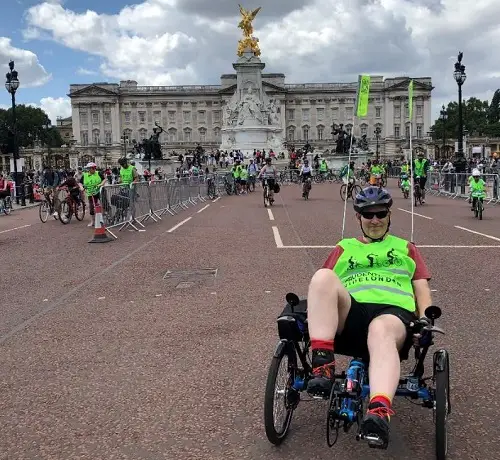
Setting personal goals and completing challenges
In October 2017, the Stroke Association organised the Thames Two Bridges Challenge, which involved an eight-mile circular course, including Chiswick and Hammersmith bridges. I set participating in this event as my own personal challenge. I organised a team of five friends and we completed the Two Bridges Challenge in 91 minutes.
Cycling together is even better!
For 2018, I took on the challenge of entering Letizia and me in the Prudential Ride London Day. I thought the prospect of being able to ride through the city and west end of London on traffic-free roads in high summer was too good to be missed. So, I entered, with the fine details of the logistics to be further investigated nearer the day. I figured that if I presented Letizia with a fait accompli, she may howl in protest, but it would be too late to back out.
To cut a long story short, the weather on the day was glorious. We cycled from Green Park station, through to City, and then back via the Embankment. We covered 22kms in total, and I got an unprecedented admission from my wife that I was right, and she was wrong!
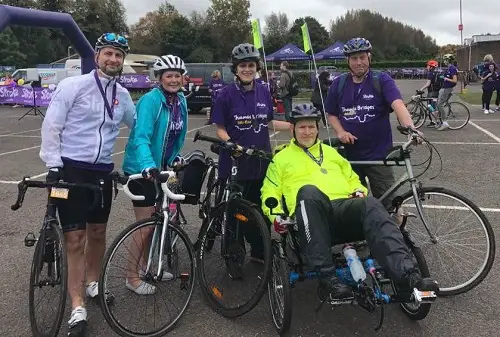
2019 and finally back to being an endorphin cycling junkie
Now it is 2019 and I am exercising for 60 minutes, three times a week on my turbo trainer. I retired in February 2018 from work, and I am looking for a new challenge. Letizia and I are building a basement gym where I can feed my endorphin addiction without having to put my toys away in the evening.
Thinking back to my reverie in the hospital bed, the sense of achievement I feel is immense. I’m well on my way back to re-joining the human race!
By Nick Cole
More on Disability Horizons…